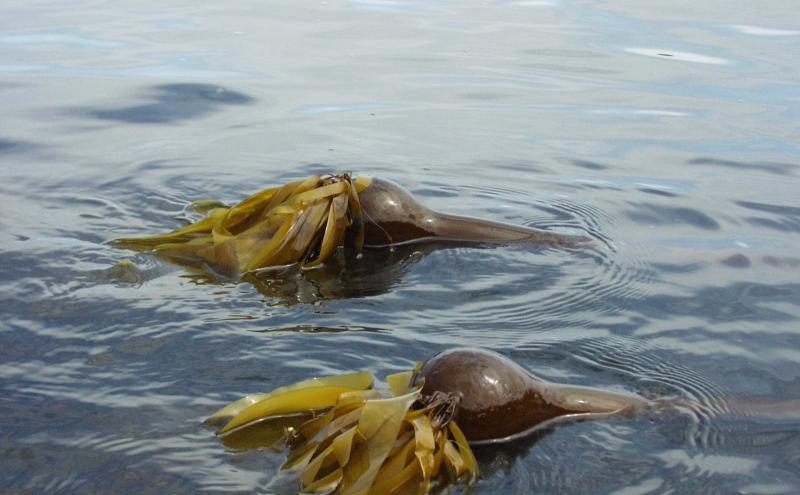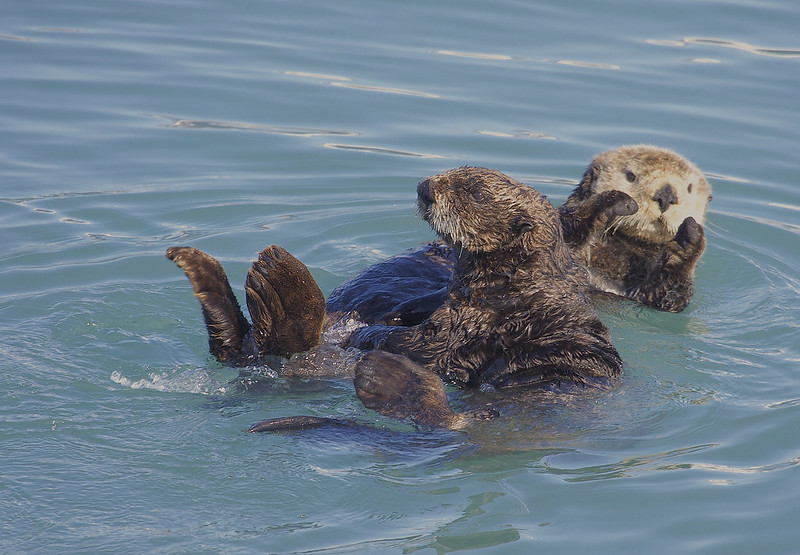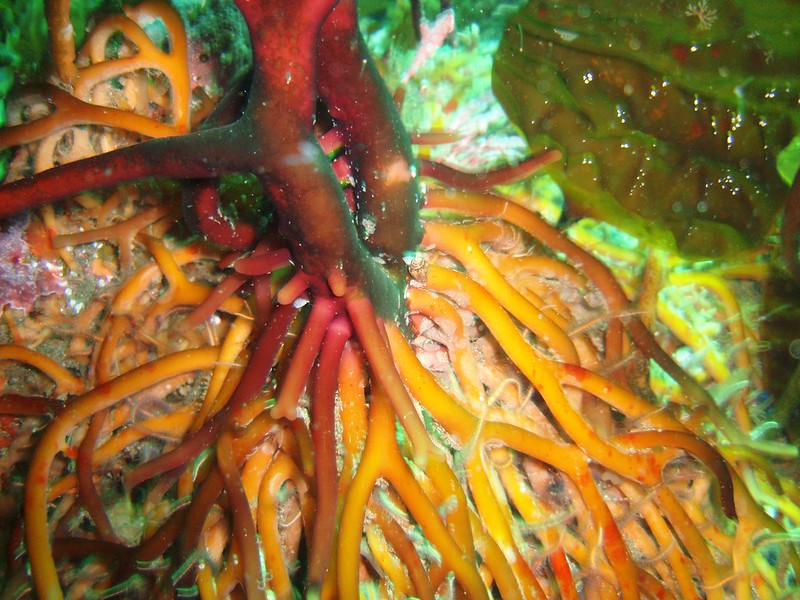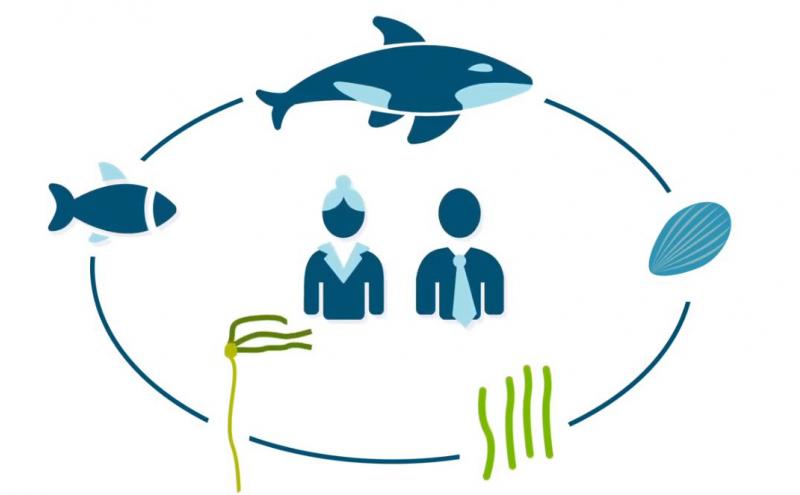
By Katie Byrnes, Washington Sea Grant Hershman Fellow
With 22 native species, Washington state has one of the most diverse populations of kelp in the world. Bull kelp is the primary canopy forming species in Puget Sound, teeming with life, and found growing along much of the coastline. Growing kelp beds is an essential part of the action plan for the Smith Cove Blue Carbon project to build and preserve habitat.
Fact 1: Kelp forests resemble forests on land
Bull kelp grows in dense beds called “kelp forests” because they look like the dense forests on land. But kelp isn’t a plant or a tree it’s a brown macroalgae, more commonly known as seaweed.
Bull kelp begins its lifecycle on the ocean floor, where rootlike structures called holdfasts attach to large rocks, anchoring the kelp in place. However, unlike the roots of a tree, holdfasts don’t absorb nutrients or water. From the holdfast grows a vertical stipe, similar to the trunk of a tree. Atop the stipe is a hollow, gas-filled bulb that allows the fronds growing from it to float on the ocean’s surface to form a canopy. This canopy absorbs sunlight needed for photosynthesis, much like the leaves of a tree.
Fact 2: Kelp removes carbon dioxide from the ocean through photosynthesis
The ocean absorbs about a quarter of the world’s carbon dioxide (CO2) emissions which come from natural (decomposition) and manmade sources (burning fossil fuels). When CO2 dissolves in seawater a chemical reaction occurs that lowers the ocean’s pH and increases its acidity. This process, called ocean acidification, has adverse effects on marine organisms, especially shell-forming organisms like clams, oysters, and scallops that have difficulty building and maintaining shells in acidic seawater.
Kelp can help protect Puget Sound because as it grows it pulls and retains (or sequesters)CO2 from the ocean. This creates a buffer zone around kelp forests where pH is higher than the surrounding water and the effects of ocean acidification are reduced.
The 2020 Puget Sound Kelp Conservation and Recovery Plan reported that in Washington alone, kelp forests uptake 27 to 136 metric tons of carbon per day, equivalent to the emissions of 2,000 to 10,500 vehicles per year. As one of the most productive ecosystems globally, kelp forests play an important role in climate change mitigation.
Fact 3: Kelp forests are a home for thousands of species
Bull kelp plays an important role in creating habitat and providing food resources to support the species that live within it. Kelp forests are utilized by more than 1,000 species including commercially important rockfish, threatened and endangered salmonids, sea otters, cormorants, and great blue herons. Kelp forests ultimately support the top marine predators like the Puget Sound’s resident killer whales.
You may sometimes notice a sea otter (or two) entangled in the floating kelp canopy. The buoyant kelp holds sea otters in place, preventing them from floating away while they’re sleeping. Besides adding charisma to kelp forests, sea otters also play a critical role in maintaining their vitality. They eat species like sea urchins, who snack on delicate kelp fronds. Without sea otters, sea urchins can decimate kelp beds, leading to habitat destruction and the loss of an important carbon filter.

Fact 4: Kelp protects the coast from storms
Bull kelp grows in the shallow, rocky waters that make up our intertidal zone. Since kelp depends on sunlight for photosynthesis, it’s typically found growing in water that’s less than 20 meters deep.
Kelp helps to stabilize the intertidal zone just by growing in it. The rootlike holdfasts anchor kelp firmly in place and its tough (but flexible) stipes act as a barrier between the coastline and intense waves that can cause erosion over time. The presence of kelp in our coastal waters is increasingly important as we experience more frequent storms and the rise of sea level.

Fact 5: Kelp can grow up to two feet a day!
Bull kelp is an annual species that grows from a microscopic seedling to upwards of 30 meters long in a single growing season which spans spring through summer. Kelps begin to decay and die off in the fall and winter months and are sometimes washed ashore where you may see them populating local beaches.
To reach this incredible height, bull kelp grows rapidly throughout its short growing season, sometimes up to two feet per day. Bull kelp is able to do this in part because it grows in a high energy environment where tidal currents and waves bring an influx of nutrients daily.
Help for kelp from the state
On March 8th, 2022, the Washington House agreed to amendments in SB 5619, including one provided by the Port. It was then sent on to the Governor for his signature. This bill was brought forward at the request of the Department of Natural Resources (DNR) to promote conservation and restoration of kelp forests and eelgrass meadows.
The Port’s proposed amendment directs the DNR to include in their recovery plan for native kelp forests and eelgrass meadows in Puget Sound and along the Washington coast an evaluation of the: “Awareness, action, and engagement tools being used by public and private entities in the Puget Sound region to raise awareness of the importance of conserving and restoring native kelp forests and eelgrass meadows and reducing stressors related to their decline.”
“It’s critical that the public gain a greater appreciation of the role kelp and eelgrass play in providing critical habitat for marine species, as well as reducing the impacts of climate change on ocean acidification, if we are to restore the Salish Sea and all those dependent on it” said Port Commissioner Fred Felleman.
Top photo credit: "bull kelp (Nereocystis luetkeana) forest" by TurasPhoto is marked with CC BY-NC 2.0.




